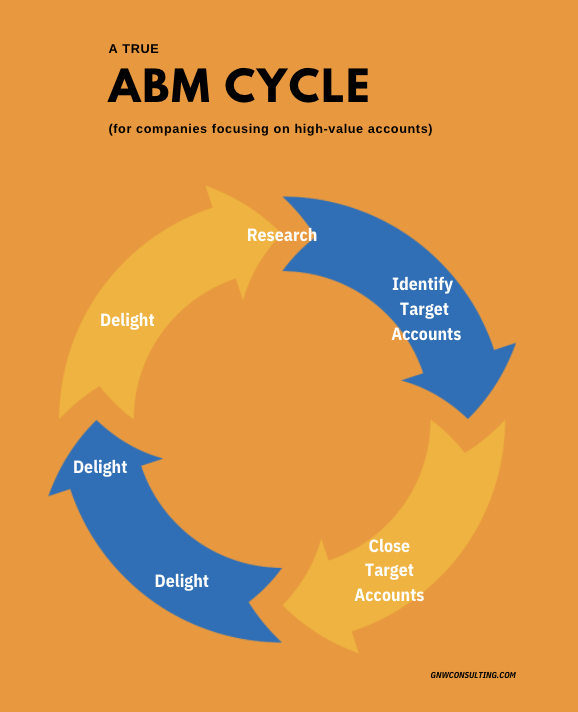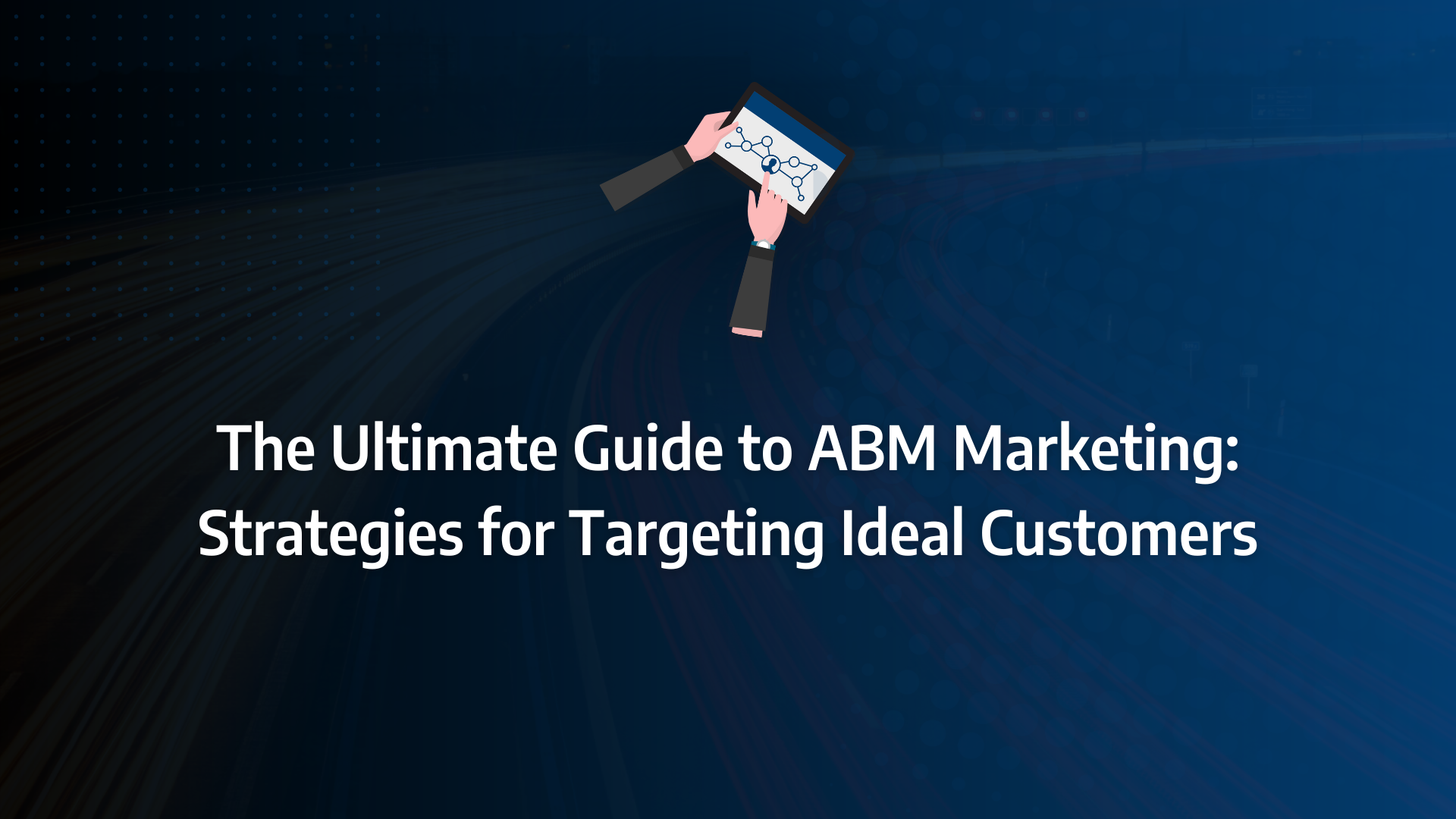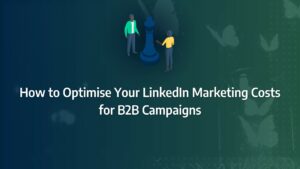Targeting the right accounts with the right message is crucial for maximising your marketing ROI. But where do you start? This guide is designed to take the guesswork out of ABM execution.
We’ll walk you through each step, from identifying high-value accounts to creating personalised campaigns that resonate. By the end, you’ll have a clear roadmap to align your sales and marketing efforts, ensuring your ABM strategy is not just theoretical but actionable and impactful.
- Identify High-Value Accounts: Start your ABM strategy by pinpointing the accounts that offer the most significant potential for long-term value.
- Align Sales and Marketing: Ensure that your sales and marketing teams are fully aligned to create a cohesive ABM approach that targets and nurtures key accounts effectively.
- Create Personalised Campaigns: Develop tailored content and messaging that speaks directly to the unique needs and pain points of each target account, increasing engagement and conversion rates.
- Leverage Data Analytics: Use advanced data analytics to refine your account selection process and optimise campaigns in real-time, ensuring you’re always targeting the right accounts with the right message.
- Measure ABM Success: Regularly track and measure the success of your ABM efforts using specific KPIs, allowing for continuous improvement and greater ROI from your marketing campaigns.
Why Choose Account-Based Marketing?
For business-to-business (B2B) organisations, converting high-value leads into customers can often be a significant challenge. The solution lies in crafting tailored, personalised experiences that not only resonate with B2B decision-makers but also drive a higher return on investment (ROI).
Account-Based Marketing (ABM) is a strategic ABM marketing approach used within B2B sales and marketing. It requires both teams to collaborate closely in targeting specific high-value accounts that align well with the brand. By focusing on a select group of prospects, ABM aims to convert these valuable opportunities into tangible sales.

What Matters Most?
We typically find the most significant impact on ABM success often comes from fostering a culture of shared ownership between sales and marketing. Clients typically discover that this collaboration not only enhances alignment but also improves overall results. Additionally, focusing deeply on understanding buyer personas enables teams to create personalised content that resonates, resulting in higher engagement.Get In Touch
1. Aligning Sales and Marketing Teams
An ABM marketing strategy creates harmony between sales and marketing by uniting both departments around the shared objective of acquiring and nurturing high-value target accounts. This approach fosters collaboration, enhances communication, and boosts overall operational efficiency, leading to more favourable business outcomes.
With an ABM execution, the teams jointly identify a list of target accounts and craft account-specific strategies, ensuring that content and campaigns are tailored to each high-value target. This alignment leads to deeper communication, shared objectives, and a streamlined effort to strengthen relationships with target prospects.
2. Efficient Use of Resources
Traditional broad-based marketing campaigns often stretch resources thin, spreading efforts across a wider field and resulting in diluted messaging and lower-quality leads. In contrast, an ABM marketing approach is more focused and efficient, allowing teams to concentrate on high-value prospects.
By aligning resources through ABM execution, sales and marketing teams can focus on driving more meaningful engagements. ABM simplifies the nurturing process with highly targeted, specific messaging that reflects the unique needs of each account, ensuring higher-quality interactions.
3. Leveraging Data-Driven Insights
Working closely with sales and customer success teams enables marketers to develop more accurate ideal customer profiles. By utilising data from existing customers and market research, ABM ensures campaigns are more targeted and effective, focusing on accounts that resemble past successful clients.
Additionally, data from previous ABM marketing campaigns can be used to optimise new go-to-market strategies. By learning from past performance, teams can increase engagement rates, fine-tune their approach, and develop more impactful campaigns for target accounts.
4. Shorter Customer Lifecycles and Accelerated Sales Cycles
At its core, an ABM marketing strategy focuses on reaching high-potential accounts early in the decision-making process. By delivering the right content to the right contacts at the right time, ABM influences key decision-makers even before they engage with a sales representative.
Given that purchase decisions in many organisations involve multiple stakeholders, an ABM marketing approach ensures that communications reach all relevant parties—decision-makers, influencers, and champions alike. This holistic targeting leads to more internal discussions, accelerating the sales cycle and generating more sales-ready leads.
5. Enhanced Personalisation
Because ABM marketing is built on strong sales and marketing alignment and detailed data-driven insights, campaigns can be far more personalised than traditional marketing efforts. The insights gathered during the planning stages enable teams to tailor content specifically to the needs and challenges of each target account, fostering stronger relationships.
Through this personalised ABM execution, prospects feel as though the messaging is uniquely crafted for them, creating a deeper connection compared to generic, one-size-fits-all campaigns. This level of personalisation helps businesses differentiate themselves and build trust with potential clients.
6. Increased Engagement
Crafting engaging content is at the heart of successful ABM marketing tactics. The research conducted on existing customer accounts, coupled with the collaboration between sales and marketing, ensures that content speaks directly to the needs of the target accounts.
By focusing on a limited number of high-value accounts, the content teams can produce messaging that is specifically tailored to address the pain points of those businesses. When prospects receive content that truly aligns with their challenges, engagement rates rise, leading to more meaningful interactions and, ultimately, higher conversion rates.
The Types of ABM You Need to Understand
One-to-One Marketing: Strategic ABM
Strategic ABM, also known as one-to-one ABM marketing, focuses on high-value, existing accounts. In this ABM marketing approach, sales, marketing, and executive teams work closely to strengthen relationships with these key customers, often with the aim of upselling or cross-selling additional products and services. This highly personalised method involves creating hyper-targeted marketing plans that address the specific needs of one to five accounts.
Due to the resources required, this ABM execution demands a deep understanding of each customer’s unique challenges and goals. As such, it’s not uncommon for businesses to spend months, or even years, nurturing these relationships. The return on investment (ROI) is typically measured over the long term, making it a strategy that requires both patience and commitment.
From developing detailed buyer personas to conducting in-depth research, every element of the campaign should be designed to deliver messaging that resonates on a personal level. For companies with larger budgets, high-value clients, and sufficient time, one-to-one ABM marketing tactics represent an ideal strategy for driving sustained growth.
One-to-Few Marketing: ABM Lite
Sitting between one-to-one and one-to-many approaches is one-to-few marketing, commonly referred to as ABM lite. Here, sales and marketing teams target second-tier accounts—typically five to ten—that share similar business goals, challenges, and needs. While the level of personalisation is not as granular as in strategic ABM, this approach still offers a significant degree of customisation.
ABM marketing tactics within the one-to-few model enable businesses with more flexible budgets to effectively engage multiple accounts simultaneously. This method still requires a solid understanding of your ideal customer profiles, personas, and segments to ensure that messaging remains relevant to each group.
ABM lite is a practical solution for companies that want to scale their ABM efforts without stretching resources too thin. It strikes a balance between broad outreach and targeted engagement, allowing for ABM marketing execution that is both effective and resource-efficient.
Source: Linkedin
One-to-Many Marketing: Programmatic ABM
At the broadest end of the spectrum is programmatic ABM marketing, or one-to-many marketing. This approach groups hundreds, even thousands of accounts together based on shared characteristics such as industry, goals, or challenges. Programmatic ABM relies heavily on automation, with tools like HubSpot, Marketo, or Pardot enabling marketing teams to manage and target large volumes of accounts.
Although programmatic ABM marketing tactics are less personalised than other forms of ABM, they still centre the customer in the marketing process. Personalisation is achieved at scale by grouping accounts that share similar needs and tailoring content to meet these broad criteria.
For smaller businesses or those with limited budgets, programmatic ABM marketing offers an entry point into account-based marketing. It’s a way to harness the power of ABM without requiring the same level of resources as one-to-one or one-to-few ABM marketing approaches.
To implement this strategy, many businesses use identifiers such as email or phone numbers to segment their audiences. LinkedIn Ads is a particularly effective platform for targeting the buying committees of companies that match your ideal customer profile (ICP), either by using LinkedIn’s ad manager or by uploading a contact list.
For broader reach, programmatic connected TV (CTV) platforms, such as Vibe, provide an opportunity to reach target audiences through networks they already engage with. Programmatic CTV leverages familiar ad management tools, offering businesses a versatile way to expand their ABM execution across digital channels.
What is the Difference Between Account-Based Marketing (ABM) and Traditional Marketing in Business-to-Business (B2B) Industries?
Traditional Marketing Approach
Traditional marketing refers to long-established methods used by businesses to promote products or services. These approaches focus heavily on mass media and offline channels to reach broad audiences. Unlike digital marketing, which leverages the power of the internet and various online platforms, traditional marketing has been in use long before the digital age.
Common forms of traditional marketing include:
- Print Advertising: Ads placed in newspapers, magazines, brochures, and flyers to reach local or regional audiences.
- Broadcast Advertising: This encompasses television and radio commercials, where businesses produce short video or audio clips to promote their offerings to a wide audience.
- Outdoor Advertising: Billboards, posters, banners, and transit ads (such as on buses or trains) are displayed in high-traffic areas to catch the attention of passers-by.
- Direct Mail: Marketers send physical promotional materials—catalogues, postcards, or samples—directly to consumers’ mailboxes, often targeting specific demographics or regions.
- Telemarketing: Telemarketers make outbound phone calls to potential customers to promote products or services, gather information, or conduct surveys.
- Events and Sponsorships: Companies participate in or sponsor events like trade shows, conferences, and sports events to increase brand visibility and directly engage with their audience.
- Public Relations (PR): Traditional PR involves managing a brand’s public image through press releases, media coverage, interviews, and other communications designed to cultivate a positive reputation.

These traditional marketing techniques remain relevant, particularly for businesses aiming to reach local audiences or specific demographics that are less accessible through online channels. In today’s marketing landscape, many companies opt to integrate traditional marketing with digital marketing strategies, creating holistic campaigns that span multiple platforms and engage a diverse range of audience segments.
Account-Based Marketing (ABM) vs Traditional Marketing
There are several fundamental differences between ABM marketing tactics and the more traditional methods of marketing. Understanding these distinctions is crucial for businesses aiming to optimise their strategy based on their specific objectives.
Highly Targeted Campaigns
The most significant difference lies in the level of targeting. Traditional marketing often adopts a broad, one-size-fits-all approach, casting a wide net in the hope of capturing as many leads as possible. ABM marketing, however, focuses on highly personalised campaigns aimed at specific accounts. These accounts are carefully chosen based on quantifiable factors like company size, industry, and fit within the buyer’s journey. In this way, ABM marketing tactics ensure that the content is tailored to meet the needs of individual decision-makers within target accounts.
Sales and Marketing Alignment
Another key distinction is how sales and marketing teams operate. In traditional marketing, sales and marketing departments typically work in silos, with little direct collaboration. In contrast, ABM marketing strategies depend on close alignment between these teams. Both sales and marketing work together to target the right accounts and create personalised content for each role within the Ideal Customer Profile (ICP). This collaboration is essential for the success of ABM execution, as it ensures that the message is consistent and relevant across the entire buyer’s journey.
Focus on Accounts, Not Leads
Traditional marketing tends to concentrate on generating leads, often prioritising volume over quality. ABM marketing approaches take the opposite stance by focusing on accounts rather than individual leads. The goal is to build deeper, more meaningful relationships with a smaller set of high-value accounts. This strategic focus on nurturing specific accounts helps companies achieve stronger long-term results.
ABM vs Traditional Marketing: Which is Better?
The answer to this question depends largely on your business goals and resources. If your aim is to generate a large volume of lower-quality leads, then traditional marketing might be a better fit. It is ideal for broad, general outreach where the focus is on increasing visibility and casting a wide net.
However, if your goal is to target specific high-value accounts within a particular market, build long-lasting relationships, and tailor your messaging to individual decision-makers, then ABM marketing is the optimal choice. When combined with inbound marketing, ABM marketing strategies offer a powerful approach that drives deeper engagement, more significant ROI, and a more predictable pipeline.
What Does an ABM Marketing Strategy Involve?
Key Elements of ABM Marketing Strategies
A successful ABM marketing strategy leverages several key tactics, each designed to target high-value accounts with personalised and precise messaging. Below are the fundamental elements of an effective ABM marketing approach.
1. Events
In-person events continue to be one of the most powerful ABM marketing tactics for engaging decision-makers within your ideal customer profile (ICP). Through a well-executed ABM execution, these events can become highly personalised experiences. This might involve sending customised invitations to key prospects, hosting exclusive VIP dinners, or offering personalised gifts and promotional items tailored to specific accounts. The personalisation should extend to follow-ups after the event, ensuring continued engagement and relationship building with target accounts.
2. Webinars
Webinars, much like events, can be tailored specifically for target accounts, providing relevant, timely content that resonates with the decision-makers within those organisations. According to the 2023 BrightTalk LeadGen report, 97% of respondents favoured webinars as their primary method for learning about vendors, reinforcing their effectiveness as a key ABM marketing tactic.
In a well-structured ABM execution, webinars are not just generic presentations but are customised to the needs of the targeted accounts. From the content to the follow-up communication, each element is designed to provide value and foster engagement with the key decision-makers.
- Email Campaigns
While direct mail offers a more tactile approach, email remains a crucial component of any ABM marketing approach. Unlike traditional volume-based email campaigns that rely on templates and automation, ABM marketing focuses on crafting highly personalised messages for each individual and company within the target accounts.
By tailoring each email to the recipient’s specific needs and pain points, ABM marketing tactics help to ensure that your outreach stands out in crowded inboxes, delivering content that feels bespoke to the recipient’s business challenges.
4. Paid Advertising
Paid advertising, particularly pay-per-click (PPC) and social media ads, plays a vital role in an ABM execution. Platforms such as LinkedIn and Facebook allow for granular targeting, ensuring your ads are displayed to the right companies and decision-makers. By using advanced technologies like IP targeting and retargeting, you can further refine your audience to focus on specific accounts, ensuring that your message reaches those who matter most.
In the context of ABM marketing, PPC initiatives are typically aligned with broader campaigns, such as promoting an event or webinar. They may also be employed in a halo campaign to maintain brand visibility and engagement following an RFP submission.
5. Web Personalisation
Finally, ABM does not end with driving traffic to your website. Once your target accounts arrive, web personalisation technology enables you to create a tailored experience based on the specific company visiting your site. This could involve personalised landing pages, bespoke content recommendations, or customised messaging that addresses the specific needs of each target account.
A successful ABM execution ensures that the user experience on your website is as targeted and relevant as the other elements of your ABM campaign, offering a seamless journey from initial engagement to conversion.
Our Tactical Recommendations
Utilising predictive analytics can significantly enhance your ability to identify high-value accounts, allowing you to allocate resources more effectively. We recommend adopting multi-channel approaches to ensure consistent messaging across platforms, which helps in effectively reaching and engaging target accounts.Get In Touch
Step-by-Step Guide to Your ABM Marketing Strategy
Step 1: Build a Cross-Functional Team
The first and often most challenging step in implementing a successful ABM marketing strategy is aligning your marketing, sales, and C-suite executives. This alignment goes far beyond occasional meetings to review progress; it’s about fostering collaboration throughout the entire process. Together, these teams must identify high-value accounts and create personalised messaging that speaks directly to their needs. This is not a task to be undertaken by marketing or sales teams in isolation—true alignment is critical for successful ABM execution.
To maintain agility, keep the team lean—five members is ideal. Encourage open communication and constructive feedback while ensuring that each team member has clear responsibilities to keep the alignment strong as the campaign evolves.

Step 2: Decide on Your ABM Tech Stack
Choosing the right tools is crucial for effective ABM execution. The tools you select will enable your team to plan, create, and measure the effectiveness of your ABM marketing tactics across every stage of the campaign. Here’s what you’ll need:
Communication Tools
Effective communication within your team is paramount. Whether through Slack, email, or project management platforms like ClickUp or Asana, ensure that everyone is on the same page from the outset. Clear communication channels increase the chances of success—not just for marketing but across all departments.
One tool we recommend is Loom. When working across time zones or when quick meetings aren’t feasible, Loom allows you to record and share video messages to keep everyone updated in real time.
A Robust CRM System
A strong CRM system is the backbone of any successful ABM marketing approach. HubSpot’s ABM workflow templates can help sort companies by their Ideal Customer Profile (ICP), making it easier to identify leads that are a good fit for your campaign. Additionally, the platform offers custom messaging tools to send personalised communications while tracking engagement metrics. HubSpot’s ABM dashboard and reporting templates also provide a clear way to track progress and ensure you remain on course.
Website Analytics Tools
Data is critical to a successful ABM marketing strategy. An analytics tool such as LeadFeeder can track who is visiting your website and identify the company they represent. This information can then be integrated with your CRM, enabling your team to add new accounts to your ABM list automatically. From there, a sales development representative (SDR) can work on moving the contact through the sales funnel.
Person-Based Advertising Platforms
For personalised ABM marketing tactics, your target accounts need to see content that speaks directly to them. Tools like Influ2 allow you to target specific individuals (not just companies) by their IP address, offering detailed insights into how and when they engage with your content. This level of personalisation helps refine your strategy and maximise the impact of your ABM execution.
Data Mining Tools
To grow your database effectively, tools like ZoomInfo are invaluable. ZoomInfo gathers detailed profiles of companies and their key decision-makers, offering insights into market trends, industry data, and sales intelligence. While gathering this data manually is an option, tools like ZoomInfo save considerable time and offer a single, comprehensive view of your target accounts.
Social Media Platforms
Social media remains a critical platform for ABM marketing. LinkedIn is a particularly powerful tool for reaching key decision-makers by targeting specific job titles or industries. As ABM continues to evolve, platforms like X (formerly Twitter) and Reddit are also becoming valuable channels for engaging with your audience.
Step 3: Account Selection & Ideal Customer Profile (ICP)
The foundation of a successful ABM marketing strategy begins with selecting the right target accounts. This should be a collaborative process involving the marketing, sales, and management teams. A mix of firmographic data, business intelligence, and strategic insight is essential to define, discover, and prioritise high-value accounts. There’s little point in targeting companies that your leadership team does not view as strategically significant, so alignment with your organisation’s broader goals is crucial.
To build a robust ABM marketing approach, the first step is defining your Ideal Customer Profile (ICP). The ICP represents the accounts and decision-makers that are an almost perfect fit for your product or service. These are the companies whose profiles mirror your most profitable current clients—those you’d want to replicate. In defining your ICP, consider factors such as revenue potential, market influence, ease of sale, and the potential for higher-than-average profit margins.
In many cases, it makes sense to start by targeting companies already in your CRM. If you have previously engaged with decision-makers from these companies, it offers a natural entry point for your ABM execution.
Source: Linkedin
Mapping Accounts and Key Players
Once you have identified your target accounts, the next critical step is mapping them out and identifying the key internal players. Gaining a deep understanding of how these companies are structured and who the primary decision-makers are will allow you to create personalised messages that resonate. Knowing their specific pain points, challenges, and goals enables you to tailor your ABM marketing tactics effectively, ensuring your approach addresses their needs in a targeted way.
Your strategy should also include understanding how decisions are made within these organisations and which individuals or influencers play a key role in those decisions. Once you have a clear picture, you can create focused marketing plans designed to help you meet specific objectives.
Building Your Account List
Through years of experience auditing ABM marketing campaigns, I’ve seen a clear distinction between successful and underperforming initiatives. The key difference often lies in how accounts are selected for the campaign. Let’s start by examining common pitfalls in ABM execution.
Some typical but flawed approaches to account list building include:
- Wish lists from sales (e.g., “We want to sell to Apple”) without consideration of realistic engagement possibilities.
- Lists of lost deals from sales—opportunities that were missed due to objective reasons, which ABM won’t necessarily resolve.
- Broad firmographic criteria (e.g., “SaaS companies from North America with 100+ employees”) that often result in a list of companies unaware of your product or with no immediate need. These companies are more likely to ignore your outreach.
Selecting the Right Accounts for a Pilot Campaign
Instead of taking broad approaches, focus on more targeted sources to select accounts that are genuinely likely to engage. Here are four methods to consider:
- Intent Data Tools like Leadfeeder or Clearbit can help you identify companies that are actively engaging with key pages on your website, such as pricing, case studies, or demo booking pages. By defining an engagement threshold, you can extract a list of accounts that are already showing interest, making them prime candidates for your ABM marketing strategy. This is a technique we frequently employ at Fullfunnel.io with great success.
- Demand Generation Programmes Review your demand generation activities, including webinars, newsletters, thought leadership pieces, and podcasts. Are there companies that engage consistently with your content? Look for patterns, such as multiple people from the same company attending webinars or engaging with several of your campaigns. These accounts could be excellent candidates for ABM execution.
- Personal Networks of Senior Executives and Sales Teams If your company doesn’t have robust demand generation programmes or relevant traffic, leveraging personal networks can be a highly effective strategy. Analyse the connections of your senior executives and sales teams that fit your ICP. Then, assess the strength of these relationships and consider starting a pilot ABM marketing campaign with those companies that have stronger ties.
- Industry Associations and Communities For businesses targeting specific, often conservative, industries, partnering with relevant associations can be an effective way to build your target list. For example, one of our clients targeting the HVAC industry partnered with a regional association to run a market research project and exclusive event for its members. This partnership helped promote the event and offered introductions to key target accounts, which we then engaged through ABM marketing tactics.
Step 4: Create Personalised Content for ABM Marketing
In ABM marketing, creating highly personalised content that speaks to the specific needs of decision-makers within your target accounts is crucial. The more tailored the content, the greater the impact. ABM marketing tactics rely on addressing the individual pain points and motivations of each key player involved in the decision-making process.
Here’s a step-by-step guide to creating personalised content for a successful ABM execution:
Step 1: Identify the Decision-Making Unit (DMU)
Once your Ideal Customer Profile (ICP) is clearly defined, the next step is identifying the Decision-Making Unit (DMU) within your target companies. The DMU consists of the individuals who have a significant influence over purchasing decisions.
To achieve a truly personalised ABM marketing approach, you need granular intelligence on each member of the DMU. Here’s how you can gather this information:
- Research each individual thoroughly, including their role and influence within the organisation.
- Develop a LinkedIn ABM marketing campaign to connect with these decision-makers.
- Conduct additional online research to uncover more about their professional goals and challenges.
- Craft messaging that speaks directly to the individual, not just the company as a whole.
Consider what motivates each member of the DMU. What specific factors would influence them to purchase your product? Understanding their unique drivers allows you to create highly targeted and effective messaging that resonates with each person.
Step 2: Define Their Pain Points
Every member of the DMU will have distinct pain points. Some might be focused on reducing costs, others on increasing efficiency, while some are concerned with expanding sales or streamlining existing processes. It’s essential to pinpoint these pain points for each individual in order to create content that addresses their specific needs.
Collaborate with your sales team to gather insights, as they often work closely with potential clients and have invaluable knowledge of the issues facing decision-makers. Sales reps gain detailed information during their qualification and discovery calls, and this data can be a goldmine for crafting effective ABM marketing tactics.
Once you’ve identified the pain points, use these insights to create content that provides solutions. The goal is to demonstrate that your offering can alleviate their challenges and provide tangible value.
Step 3: Choose the Right Medium
In most organisations, seven to eight key influencers are involved in every purchasing decision. Each of these influencers may respond better to different types of content, so it’s important to diversify your approach.
Some of the most effective content formats in ABM marketing include:
- Blogs
- Videos
- Case studies
- Whitepapers and guides
- Webinars and podcasts
- Direct mail and letters
- Templates and checklists
- Reports and surveys
With such a wide array of options available, how do you determine the right medium for each decision-maker? Your sales team can provide invaluable insights based on their experience with different buyers. Aligning your ABM marketing strategy with your sales team ensures that the content you produce will resonate with your audience across multiple touchpoints.
Step 4: Select the Right Channels
Knowing where to promote your content is just as important as knowing what content to produce. Your ABM execution must align with the digital habits of your target audience.
Refer back to your ICP and ask yourself: Where do your prospects spend their time online? Which social media channels are most relevant to them? Are they more engaged on LinkedIn, Twitter, or perhaps a niche industry forum?
You’ll also want to review the data from your own social media and email campaigns to see which channels have generated the most engagement from your target accounts in the past. Once you have this information, you can tailor your content distribution to reach the right people in the right places.
Personalisation is key to ABM marketing engagement. Customise your messaging for each prospect, ensuring that it speaks to their unique challenges and goals.
Step 5: Timing is Everything
A successful ABM marketing strategy involves multiple steps across several channels and content types. Timing plays a critical role in ensuring the effectiveness of your outreach. For senior decision-makers, time is a valuable resource, and they are unlikely to engage with long-form content at the beginning of their buying journey.
Start with concise, impactful content at the initial stages, delivering value quickly. As the buying journey progresses and the decision-makers become more engaged, you can introduce more detailed content that helps them make an informed decision. By breaking your content into smaller pieces and delivering it at regular intervals, you’ll keep your target accounts engaged throughout the sales cycle.
What Are the Most Relevant Account-Based Marketing (ABM) KPIs?
In ABM marketing, tracking the right metrics and key performance indicators (KPIs) is essential to gauge the success of your efforts. These KPIs are centred around identifying, engaging, building relationships, and ultimately closing deals with your target account list (TAL). The focus is on evaluating engagement, intent, and progress at the account level, not just the individual lead level, which is what sets ABM marketing tactics apart from more traditional approaches.

Below are some of the most important KPIs to monitor in a successful ABM marketing strategy.
Marketing-Qualified Accounts (MQAs): A Marketing-Qualified Account (MQA) is an account that the marketing team has identified as having a high likelihood of converting into a customer. While Marketing-Qualified Leads (MQLs) focus on individual leads in traditional marketing, MQAs consider the entire account. The criteria for an MQA will vary depending on factors like the industry, company size, and level of engagement. Tracking MQAs allows you to focus your ABM execution on accounts with the highest potential for conversion.
Reach Within an Account: This metric tracks the number of contacts you have within a target account. One of the core principles of ABM marketing is engaging multiple decision-makers within a company. The more contacts you reach within an account, the better your chances of influencing the decision-making process. High reach indicates that your campaign is penetrating deeper into the account, increasing your likelihood of success.
Account Engagement: Account engagement measures how actively a target account is interacting with your marketing efforts. This could include actions like clicking on ads, opening emails, attending webinars, or visiting your website. High engagement is a strong indicator that the account is interested in your offering, making it a critical KPI in your ABM marketing strategy. The more engaged an account is, the more likely it is to move through the sales funnel.
Form Fills and Digital Engagements: This metric captures how many individuals from a target account are completing forms on your website, such as signing up for newsletters or requesting demos. Form fills provide clear intent signals, indicating that the account is progressing through the buying journey. Monitoring these engagements helps you understand where an account stands and how your ABM marketing approach is performing.
Meetings Booked: Meetings booked is a straightforward but essential KPI. It measures whether your ABM marketing tactics are leading to actual sales conversations with target accounts. A meeting is a significant milestone in the sales process, as it typically indicates a high level of interest from the account. This KPI is a key indicator of how well your campaigns are converting engagement into concrete opportunities.
Conversions and Close Rate: The conversion rate in ABM marketing refers to how many of your target accounts are converting into customers. A high conversion rate indicates that your ABM execution is successfully turning engaged accounts into clients. The close rate is an essential measure of how effective your strategy is at nurturing accounts through to the final purchase decision.
Average Contract Value (ACV): Average Contract Value (ACV) represents the average revenue generated from each closed deal. In ABM marketing, targeting high-value accounts often results in larger deal sizes, making ACV an important metric. Monitoring ACV helps you understand the financial impact of your strategy and ensures you are targeting accounts that deliver substantial returns.
Pipeline Velocity: Pipeline velocity measures how quickly accounts are progressing through your sales funnel—from MQA status to opportunity and eventually to a closed deal. Faster pipeline velocity typically indicates a more efficient sales process, suggesting that your ABM marketing approach is effectively nurturing and converting high-value accounts. A slow pipeline velocity, on the other hand, could signal bottlenecks or a need to refine your ABM execution.







